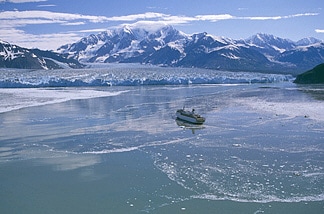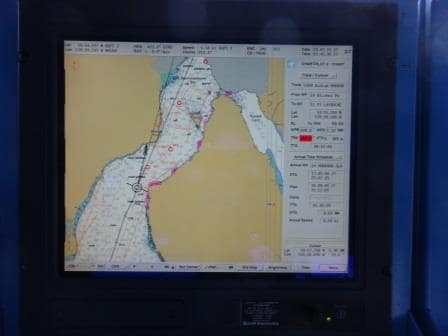And then the good ship Statendam sailed from Kodiak and headed for Yakutat Bay. It turned out to be an eventful ride. First the Bright Star alarm went off, indication a medical emergency in one of the guest cabins, and it turned out to be a real emergency. Sometime later the Captain came on the P.A system advising all of us that the Statendam had slowed down and we were waiting for a USCG Helicopter from Kodiak Air station to air lift the patient to hospital. In the meantime the weather had taken a turn for the worse and wind and swell were increasing. This is normally not much of an issue for a Helicopter as long as the winds are not hurricane force and as long as the ship is able to maneuver in such a way that the pilot can find a nice balance between the helicopter speed, the wind velocity and the ships speed.
Lift off can take place either from the bow or the stern and most of the time it is from the bow. This time the pilot opted for the stern. It is the pilot’s choice, as he/she has to make it happen. The lift off went very well and I like to think that I had a little positive voice in that as not three days earlier I had taken all the stake holders through a table top exercise about how to follow all the protocols for such an evolution. The patient is now in Anchorage and we all hope that a speedy recovery will take place.
But the slowing down and the adverse weather were not good for maintaining schedule and thus the captain had to speed up to make up time and try to make the most of it for our visit to Hubbard Glacier. We arrived a bit later than scheduled today but in principle it did not matter as it is still day light until late in the evening and thus there is no cut off time as far as that is concerned. Then we had a bit of luck; the ice was very well spread out so the Statendam could go up the bay much faster than could have been the case. To get to the Glacier is a distance of about 20 miles which means even at full speed it takes an hour. We normally plan for 2 hours, so if you can do it in 1.5 hrs. or less, you make up considerable time in the schedule.
Yakutat Bay is made up of three parts as far as our business is concerned. There is the town of Yakutat from where the pilot boat is dispatched, as the bay is in inland waters and thus pilotage is compulsory; and then there is the bay itself divided into a lower bay and an upper bay. The upper bay part starts at Point Latouche a nick in the land which was named after a French explorer who ended up there. This point is for us sailors quite significant as often there can be a lot of ice there. The constant outflow of water from the glaciers (Hubbard is the biggest one but far from the only one) pushes the ice to open sea (and the ice pieces are much bigger than in Glacier Bay) and the ocean tide pushes them back again when the flood comes in. Then there is the wind which has a certain influence and for all of those reasons the ice seems to like to congregate around point Latouche, even when the rest of the upper and lower bay is almost ice free.

I think this also shows the vast size of the area. In the centre the old Sky Princess (ex Fairsky and long since gone) being dwarfed by the size of Hubbard Glacier.
But once we were passed this ice field it was open all the way to the face. We were not the only ship there, the Seven Seas Navigator was in at the same time but the area is so big and the Glacier face so wide that you could have 5 cruise ships there without bothering each other as long as the captains are cooperating with each other. That is a lot better than it was in the past so today there was no issue at all. The Navigator kept to one side and the Statendam to the other side. Having another large cruise ship there has an advantage; the guests can see really how everything is on a massive scale here. I always had the vision of having a mock-up Empire State Building on a barge and tow that in front of the Glacier Face during the season. Not feasible but it would show how puny even such a big building would be against the vast mass of Hubbard.
After a good look around, with a considerable amount of calving going on, we turned around and sailed back to the Gulf of Alaska. We made up some time, without it affecting the Glacier experience but we will still be late in Sitka. However there are no worries, the tours were moved and the ship will simply stay a bit longer.
We will have a bit of a bumpy ride towards Sitka but inside it should be calm as we will be sheltered by the mountains.
Weather: looking at the weather chart, I am predicting a Misty-Mountain day but good visibility below mountain level. The rain might come or not. That will depend on how the rain clouds will bump against the mountains and how fast this weather system moves over.


Leave a Reply